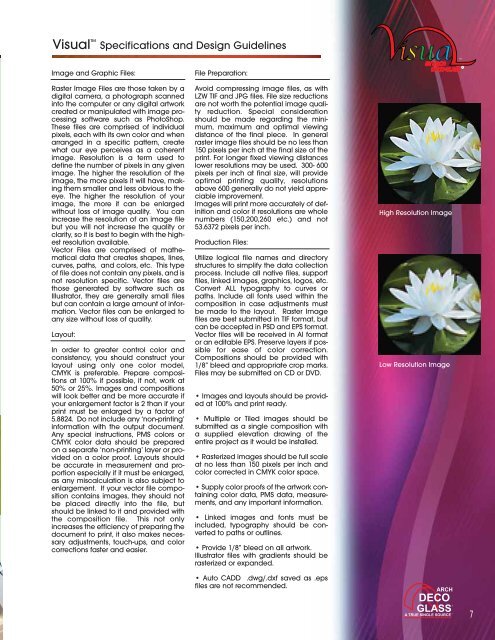Arch Deco - Roadrunner Glass
Arch Deco - Roadrunner Glass
Arch Deco - Roadrunner Glass
Create successful ePaper yourself
Turn your PDF publications into a flip-book with our unique Google optimized e-Paper software.
Visual Specifications and Design Guidelines<br />
Image and Graphic Files:<br />
Raster Image Files are those taken by a<br />
digital camera, a photograph scanned<br />
into the computer or any digital artwork<br />
created or manipulated with image processing<br />
software such as PhotoShop.<br />
These files are comprised of individual<br />
pixels, each with its own color and when<br />
arranged in a specific pattern, create<br />
what our eye perceives as a coherent<br />
image. Resolution is a term used to<br />
define the number of pixels in any given<br />
image. The higher the resolution of the<br />
image, the more pixels it will have, making<br />
them smaller and less obvious to the<br />
eye. The higher the resolution of your<br />
image, the more it can be enlarged<br />
without loss of image quality. You can<br />
increase the resolution of an image file<br />
but you will not increase the quality or<br />
clarity, so it is best to begin with the highest<br />
resolution available.<br />
Vector Files are comprised of mathematical<br />
data that creates shapes, lines,<br />
curves, paths, and colors, etc. This type<br />
of file does not contain any pixels, and is<br />
not resolution specific. Vector files are<br />
those generated by software such as<br />
Illustrator, they are generally small files<br />
but can contain a large amount of information.<br />
Vector files can be enlarged to<br />
any size without loss of quality.<br />
Layout:<br />
In order to greater control color and<br />
consistency, you should construct your<br />
layout using only one color model,<br />
CMYK is preferable. Prepare compositions<br />
at 100% if possible, if not, work at<br />
50% or 25%. Images and compositions<br />
will look better and be more accurate if<br />
your enlargement factor is 2 than if your<br />
print must be enlarged by a factor of<br />
5.8824. Do not include any ‘non-printing’<br />
information with the output document.<br />
Any special instructions, PMS colors or<br />
CMYK color data should be prepared<br />
on a separate ‘non-printing’ layer or provided<br />
on a color proof. Layouts should<br />
be accurate in measurement and proportion<br />
especially if it must be enlarged,<br />
as any miscalculation is also subject to<br />
enlargement. If your vector file composition<br />
contains images, they should not<br />
be placed directly into the file, but<br />
should be linked to it and provided with<br />
the composition file. This not only<br />
increases the efficiency of preparing the<br />
document to print, it also makes necessary<br />
adjustments, touch-ups, and color<br />
corrections faster and easier.<br />
File Preparation:<br />
Avoid compressing image files, as with<br />
LZW TIF and JPG files. File size reductions<br />
are not worth the potential image quality<br />
reduction. Special consideration<br />
should be made regarding the minimum,<br />
maximum and optimal viewing<br />
distance of the final piece. In general<br />
raster image files should be no less than<br />
150 pixels per inch at the final size of the<br />
print. For longer fixed viewing distances<br />
lower resolutions may be used. 300- 600<br />
pixels per inch at final size, will provide<br />
optimal printing quality, resolutions<br />
above 600 generally do not yield appreciable<br />
improvement.<br />
Images will print more accurately of definition<br />
and color if resolutions are whole<br />
numbers (150,200,260 etc.) and not<br />
53.6372 pixels per inch.<br />
Production Files:<br />
Utilize logical file names and directory<br />
structures to simplify the data collection<br />
process. Include all native files, support<br />
files, linked images, graphics, logos, etc.<br />
Convert ALL typography to curves or<br />
paths. Include all fonts used within the<br />
composition in case adjustments must<br />
be made to the layout. Raster Image<br />
files are best submitted in TIF format, but<br />
can be accepted in PSD and EPS format.<br />
Vector files will be received in AI format<br />
or an editable EPS. Preserve layers if possible<br />
for ease of color correction.<br />
Compositions should be provided with<br />
1/8” bleed and appropriate crop marks.<br />
Files may be submitted on CD or DVD.<br />
• Images and layouts should be provided<br />
at 100% and print ready.<br />
• Multiple or Tiled images should be<br />
submitted as a single composition with<br />
a supplied elevation drawing of the<br />
entire project as it would be installed.<br />
• Rasterized images should be full scale<br />
at no less than 150 pixels per inch and<br />
color corrected in CMYK color space.<br />
• Supply color proofs of the artwork containing<br />
color data, PMS data, measurements,<br />
and any important information.<br />
• Linked images and fonts must be<br />
included, typography should be converted<br />
to paths or outlines.<br />
• Provide 1/8” bleed on all artwork.<br />
Illustrator files with gradients should be<br />
rasterized or expanded.<br />
• Auto CADD .dwg/.dxf saved as .eps<br />
files are not recommended.<br />
High Resolution Image<br />
Low Resolution Image<br />
7


